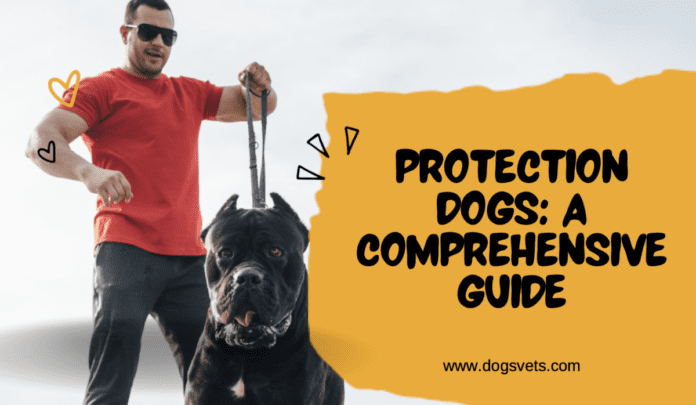Last Updated on March 23, 2023 by Dogs Vets
Protection Dogs: A Comprehensive Guide to Owning and Training a Canine Protector
If you’re in search of a loyal and dependable companion that can also serve as a personal bodyguard, a protection dog might be just what you’re looking for.
These specially trained dogs have the ability to detect threats, assess situations, and act accordingly to protect their owners.
In this comprehensive guide, we’ll cover everything you need to know about owning and training a protection dog.
What are Protection Dogs?
Protection dogs are trained canines that provide security and protection to their owners. These dogs are specifically trained to detect and respond to threats, and they can also be trained to perform tasks such as tracking, search and rescue, and even detecting drugs or explosives.
Some of the breeds that are commonly used as protection dogs include German Shepherds, Belgian Malinois, Doberman Pinschers, Rottweilers, and Boxers. These breeds are known for their intelligence, loyalty, and ability to be trained for protection work.
How to Choose the Right Protection Dog
Choosing the right protection dog for you is crucial to ensure a successful and fulfilling relationship with your furry companion. When selecting a protection dog, it’s essential to consider your lifestyle, living situation, and the level of training you’re looking for.
It’s important to work with a reputable breeder or trainer who can assess your needs and help you select the best breed and individual dog for you. Additionally, it’s crucial to evaluate the dog’s temperament, health, and working ability before making a final decision.
Training a Protection Dog
Training a protection dog is a complex and specialized process that requires the expertise of a professional dog trainer. The training process typically involves teaching the dog basic obedience commands, socialization, and advanced protection work.
During the training process, the dog will be exposed to various stimuli, including loud noises, strange people, and unfamiliar environments, to prepare them for real-life scenarios. The dog will also be trained to respond to verbal and physical commands and to detect potential threats.
Benefits of Owning a Protection Dog
Owning a protection dog can provide many benefits, including increased security and peace of mind. These dogs can also be trained to perform various tasks, such as retrieving items, opening doors, and even providing emotional support.
In addition, protection dogs can provide companionship and a sense of purpose. They require regular exercise and training, which can help their owners stay active and engaged.
Caring for Your Protection Dog
Proper care and maintenance are crucial to ensure your protection dog remains healthy and happy. Regular exercise, training, and socialization are essential for these dogs, as they require mental and physical stimulation to thrive.
It’s also important to provide your protection dog with a balanced and nutritious diet, regular veterinary care, and a safe and comfortable living environment. Additionally, it’s essential to establish a strong bond with your dog through consistent training and positive reinforcement.
Common Misconceptions about Protection Dogs
There are many misconceptions about protection dogs, including the belief that they are aggressive and dangerous. However, these dogs are trained to only respond to real threats, and they can be socialized to interact positively with people and other animals.
Additionally, some people believe that protection dogs are only suitable for law enforcement or military use. However, many protection dogs are owned by civilians and can provide the same level of security and protection as those used in professional settings.
FAQ’s
Here are some commonly asked questions about protection dogs and their answers:
What breeds are commonly used as protection dogs?
-
- German Shepherds, Doberman Pinschers, Rottweilers, and Belgian Malinois are some of the most commonly used breeds for protection work.
Can any dog be trained as a protection dog?
-
- While any dog can be trained for obedience and basic commands, not all dogs have the temperament or physical ability to be trained as a protection dog. It is important to consult with a professional trainer before attempting to train a dog as a protection dog.
What kind of training do protection dogs receive?
-
- Protection dogs receive extensive training in obedience, bite work, tracking, and scent detection. The training process can take several months to a few years to complete.
Do protection dogs make good pets?
-
- While protection dogs are trained to be loyal and obedient to their owners, they are primarily trained for protection work and may not be suitable as a family pet. It is important to consider the dog’s temperament and personality before bringing a protection dog into a family setting.
How do I choose a reputable protection dog trainer?
-
- It is important to do thorough research and choose a trainer with a proven track record of successfully training protection dogs. Look for recommendations from other dog owners, check the trainer’s credentials, and ask to see examples of their work.
Can a protection dog be trained to live with other pets?
-
- With proper training and socialization, a protection dog can coexist with other pets in the household. However, it is important to consult with a professional trainer to ensure that the dog is trained and socialized properly.
Are protection dogs legal to own?
-
- Yes, protection dogs are legal to own, but it is important to follow local laws and regulations regarding dog ownership and training. It is also important to remember that owning a protection dog comes with a great deal of responsibility and requires a significant investment of time and resources.
Fact Check
We hope you enjoyed reading this article. What are your thoughts on the topic?
“At [Dogsvets.com], our goal is to bring you the most accurate and up-to-date information on all things pet-related.
If you have any additional insights or would like to advertise with us, don’t hesitate to get in touch.
If you notice any errors or discrepancies in our content, please let us know so we can correct them.
We welcome your feedback and encourage you to share this article with others.”

















